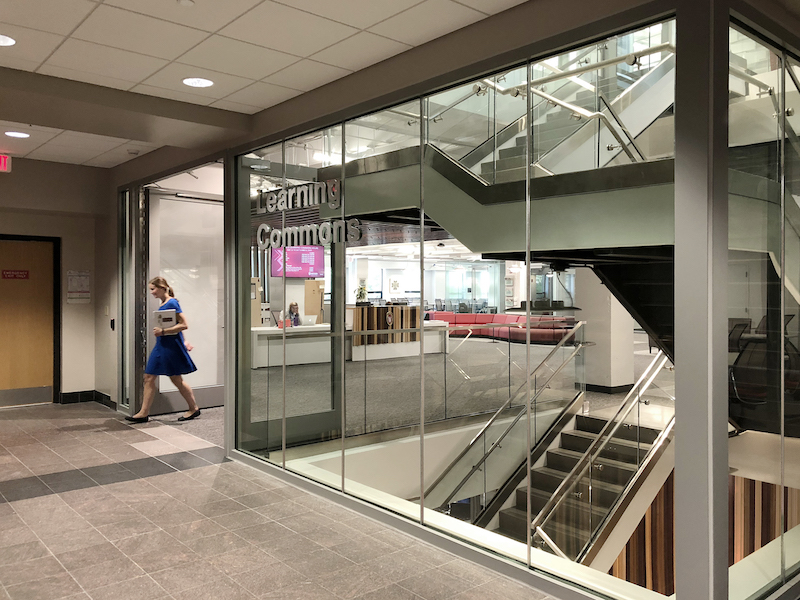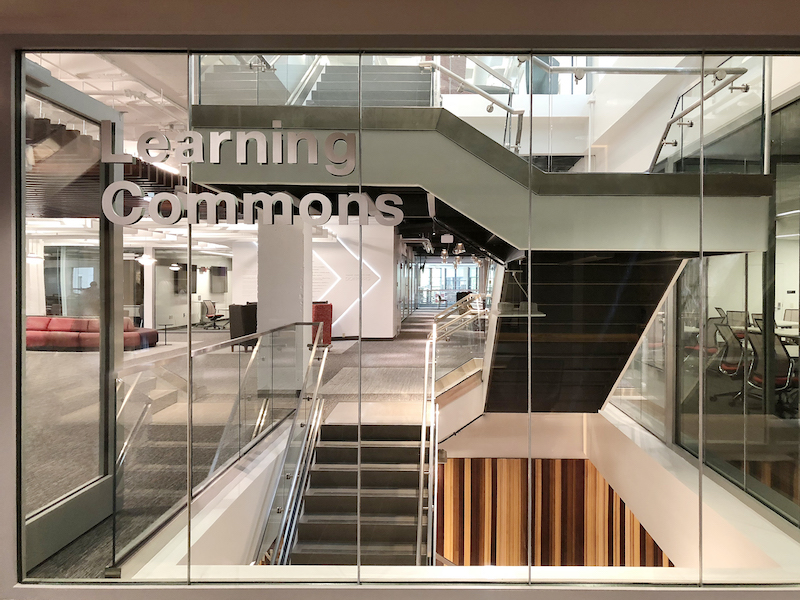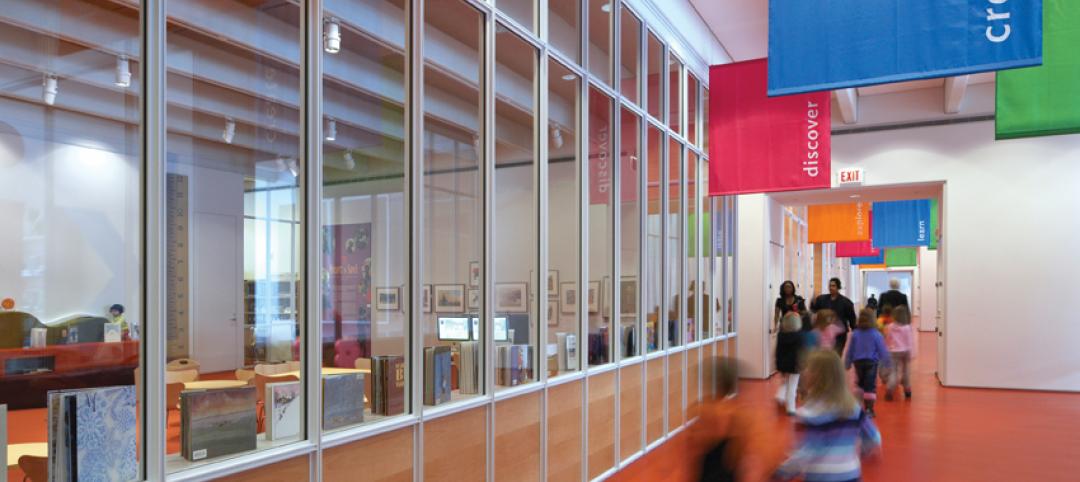When the University of Wisconsin School of Business officially opened the Learning Commons last May, it kicked off the first step in realizing the university’s grand masterplan to renovate the library buildings across the Madison campus. “The design strategy for this Learning Commons space included connecting the east and the west wings of Grainger Hall. Transparency was a key principle for making this happen,” says Scott Kammer, AIA at Potter Lawson. Incorporating transparency between spaces extended to the stairwells as well. To meet the design intent and code requirements, the architects decided to use clear, fire resistive glass walls.
Traditionally, stairwells have been relegated to the back of the building and usually reserved for emergencies as their dark, isolated surroundings made it unappealing for everyday use. The lack of vision and transparency also made it a prime spot for attacks. This all changed with the advent of clear, fire resistive glazing able to meet the ASTM E-119/UL 263 wall standard up to 2 hours. Using transparent building materials that incorporate vision and code-compliance made it possible to design stairwells that are more centrally located instead of being tucked away in the back.
This was the case for the Learning Commons. “The existing building had two separate stairs that only connected two floors each. The centrally located stairwell connected all three levels of the Learning Commons and contributed to the wayfinding experience for the users. It was critical for this stairwell to be as clear as possible to see through the space,” adds Scott.
 Image created by MSR.
Image created by MSR.
During the design phase, Scott worked with Mike White at SAFTI FIRST to explore his options. “Mike was very responsive and answered our questions in a timely manner. He included photos of similar projects, which helped us specify exactly what we needed. He was very helpful in determining if the products would work with our budget at an early stage of design,” says Scott.
To achieve maximum transparency while meeting code requirements, the architects specified 9 ft. tall, clear, fire resistive butt-glazed walls using SuperLite II-XLM in GPX Architectural Series perimeter framing. Instead of vertical mullions, SuperLite II-XLM uses a slim, 6mm butt-joint between the fire resistive glass panels to allow as much transparency as possible while still meeting the fire resistive ASTM E-119/UL 263 wall requirement.
The entrances to the stairwell also maximized vision and transparency without sacrificing safety. Building codes in the USA limit ceramics and other fire protective glazing to 100 sq. in. in the vision panels of 60-90 minute doors in interior exit stairways, ramps and exit passageways regardless if the building is fully sprinklered. To exceed the 100 sq. in. door vision panel limitation, fire resistive glazing tested to ASTM E-119/UL 263 must be used.
 Photo: Olivia Nass.
Photo: Olivia Nass.
That’s exactly what the architects did for this project. For maximum vision and transparency, they specified full-vision temperature rise doors using an ASTM E-119/UL 263 rated assembly comprised of GPX Architectural Series Doors with SuperLite II-XL glazing. The doors also matched the 9-ft. height of the clear, fire resistive butt-glazed panels adjacent to it. With other aluminum temperature rise doors having a maximum height of 8 ft. tall, going with the GPX Architectural Series aluminum temperature rise door at the full 9 ft. height eliminated the need for a transom above the door. These doors do not require a mid-rail and were supplied with custom access hardware at the architect’s request for enhanced security.
SAFTI FIRST worked closely with Omni Glass & Paint during the installation phase. Even though fire resistive butt-glazed walls are a relatively new product in the market, the installation was a pretty smooth process. “I spoke with our installers and they did not see much of a difference in the captured and butt-glazed systems as far as ease of installation,” says Robert Leffel of Omni Glass & Paint. “The service from SAFTI FIRST was good. They did all they could to minimize delays,” he adds. SAFTI FIRST’s sales and project management teams were in constant communication with Omni throughout the bidding, submittal, fabrication and delivery stages.
The result is a visually stunning, code-compliant stairwell enclosure that helps connect the various spaces in this state-of-the-art Learning Commons that is sure to be enjoyed by students, faculty and visitors for years to come.
Related Stories
| Apr 11, 2011
From Wired Glass to Clear Solutions: Designing with Fire Rated Glass Today
This white paper provides readers with a solid understanding of fire rated glass based on the two types of FRG recognized in the IBC – fire protective and fire resistive glazing. The white paper is intended to give readers the ability to specify the correct, code-approved FRG product for particular applications based on the most up-to-date version of the IBC.
| Mar 29, 2011
Chicago’s Willis Tower to become a vertical solar farm
Chicago’s iconic Willis Tower (formerly the Sears Tower) is set to become a massive solar electric plant with the installation of a pilot solar electric glass project.
| Feb 11, 2011
Four Products That Stand Up to Hurricanes
What do a panelized wall system, a newly developed roof hatch, spray polyurethane foam, and a custom-made curtain wall have in common? They’ve been extensively researched and tested for their ability to take abuse from the likes of Hurricane Katrina.
| Feb 10, 2011
7 Things to Know About Impact Glazing and Fire-rated Glass
Back-to-basics answers to seven common questions about impact glazing and fire-rated glass.
| Feb 7, 2011
President Obama cites PPG glass, coatings in Penn State speech
President Barack Obama yesterday acknowledged PPG Industries as a leader in the development of high-performance glass and coatings for energy-efficient buildings during a visit to Penn State University that kicked off the U.S. government’s “Better Buildings Initiative.’
| Jan 21, 2011
Virginia community college completes LEED Silver science building
The new 60,000-sf science building at John Tyler Community College in Midlothian, Va., just earned LEED Silver, the first facility in the Commonwealth’s community college system to earn this recognition. The facility, designed by Burt Hill with Gilbane Building Co. as construction manager, houses an entire floor of laboratory classrooms, plus a new library, student lounge, and bookstore.
| Jan 21, 2011
Music festival’s new home showcases scenic setting
Epstein Joslin Architects, Cambridge, Mass., designed the Shalin Liu Performance Center in Rockport, Mass., to showcase the Rockport Chamber Music Festival, as well at the site’s ocean views.
| Dec 17, 2010
Subway entrance designed to exude Hollywood charm
The Hollywood/Vine Metro portal and public plaza in Los Angeles provides an entrance to the Red Line subway and the W Hollywood Hotel. Local architect Rios Clementi Hale Studio designed the portal and plaza to flow with the landmark theaters and plazas that surround it.













